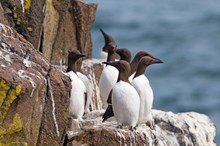04 June, 2014
Celebrating seabirds on the May
A two-day seabird celebration will take place on the Isle of May national nature reserve on the 14-15 June.
Organised by Scottish Natural Heritage (SNH), there will be experts on hand to talk about the puffins and other birds which make the Isle of May so special. The open weekend will also include story-telling, singing and face-painting.
Telescopes will be set up at viewpoints on the island and laptops will show seabird movies, including spectacular underwater footage of shags. Visitors can also learn about the research which is helping us understand our seabirds.
David Pickett, SNH’s Isle of May reserve manager, said:
“Ever wondered how a guillemot recognises its partner? Or how a puffin digs its burrow? Or how a shag catches fish? You can get answers to these questions and many more at our open weekend. The Isle of May is one of the best places in Scotland to see seabirds including puffins, with nearly 200 000 birds on the island at peak season. These two open days give you a chance to find out a bit more about these special birds by talking to the experts that study the lives of seabirds. There will also be songs, stories and face painting to get you into the bird island mood.”
Advance booking is essential.
It’s free to visit the nature reserve, but you must take a boat trip to reach the island. Sailings are on the privately-run May Princess or Osprey of Anstruther from the Anstruther Harbour or through the Scottish Seabird Centre in North Berwick.
- Anstruther - for tickets and details, see www.isleofmayferry.com (May Princess) or www.isleofmayboattrips.co.uk (RIB Osprey).
- North Berwick - For tickets and details, book online on the Scottish Seabird Centre website at www.seabird.org or call 01620 890 202.
Known locally as 'The May', this small island sits on the edge of the Firth of Forth. The island's importance for seabirds has drawn scientists to its shores for many years and the May is home to the oldest continuously running bird observatory in the UK. The May is also a regular haunt for grey seals, often seen lounging on the shoreline rocks. This island is a historical gem and it's been a place of pilgrimage for centuries with an early island monastery. The May was also the site of Scotland's very first lighthouse, built in 1636, while the current, castle-like lighthouse was designed by the engineer Robert Stevenson. For more on the Isle of May, see the May blog at http://isleofmaynnr.wordpress.com/
The Isle of May is one of more than 50 national nature reserves in Scotland. These are special places that look after some of the best of Scotland’s nature on behalf of everyone who lives or visits Scotland, and they provide unique opportunities to visit, enjoy and learn more about Scotland’s nature. For more information, see www.nnr-scotland.org.uk.
Contact information
- Name
- SNH Media
- snhmedia@snh.gov.uk
NatureScot is Scotland's nature agency. We work to enhance our natural environment in Scotland and inspire everyone to care more about it. Our priority is a nature-rich future for Scotland and an effective response to the climate emergency. For more information, visit our website at www.nature.scot or follow us on X at https://x.com/NatureScot
’S e NatureScot buidheann nàdair na h-Alba. Bidh sinn a’ neartachadh àrainneachd na h-Alba agus a’ brosnachadh dhaoine gu barrachd suim a chur ann an nàdar. Tha e mar phrìomhachas againn gum bi nàdar na h-Alba beairteach agus gun dèilig sinn gu h-èifeachdach le èiginn na gnàth-shìde. Tha an tuilleadh fiosrachaidh aig www.nature.scot no air X aig https://x.com/NatureScot

